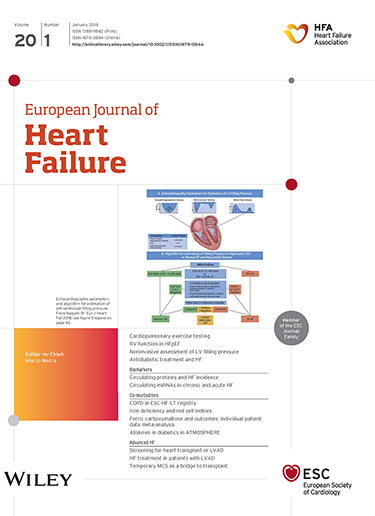心力衰竭和射血分数轻度降低或保留的患者贫血:FINEARTS-HF试验的预先指定分析
IF 10.8
1区 医学
Q1 CARDIAC & CARDIOVASCULAR SYSTEMS
引用次数: 0
摘要
aimsanemia常见于射血分数轻度降低或保留的心力衰竭(HFmrEF/HFpEF),并与不良临床结果相关。虽然肾素-血管紧张素系统阻滞剂可降低血红蛋白,但对于矿皮质激素受体拮抗剂对血红蛋白和贫血患者的影响知之甚少。我们根据finhearts - hf项目中HFmrEF/HFpEF患者的贫血状态评估了芬尼酮的效果。此外,我们在随访期间检查了芬烯酮对血红蛋白、新发贫血和贫血消退的影响。方法与结果贫血定义为女性血红蛋白<12 g/dl,男性血红蛋白<13 g/dl。主要终点是总(首次和复发)心力衰竭事件和心血管死亡的综合。在分析的5665例患者中,1584例(28.0%)在基线时患有贫血。与没有贫血的患者相比,贫血患者的主要终点风险更高:事件发生率为每100人年24.3(95%可信区间[CI] 21.9-26.9)比13.1 (95% CI 12.0-14.3);发病率比[RR] 1.67 (95% CI 1.45-1.92)。与贫血消退相比,持续贫血与较差的预后相关,新发贫血患者的预后比未发生贫血的患者差。芬尼酮对主要终点的影响在有和没有贫血的患者中是一致的(RR 0.89;95% CI 0.73-1.10, RR 0.76;95% ci 0.64-0.91;相互作用p = 0.27)和基线血红蛋白范围。芬那酮治疗并没有增加贫血的消退或预防新发贫血。结论:不论贫血状态如何,芬纳酮均可降低临床结局的风险。临床试验注册ClinicalTrials.gov NCT04435626。本文章由计算机程序翻译,如有差异,请以英文原文为准。
Anaemia in patients with heart failure and mildly reduced or preserved ejection fraction: A prespecified analysis of the FINEARTS-HF trial.
AIMS
Anaemia is common in heart failure with mildly reduced or preserved ejection fraction (HFmrEF/HFpEF) and associated with poor clinical outcomes. While renin-angiotensin system blockers reduce haemoglobin, little is known about the effect of mineralocorticoid receptor antagonists on haemoglobin and in patients with anaemia. We evaluated the effects of finerenone according to anaemia status in patients with HFmrEF/HFpEF enrolled in FINEARTS-HF. Additionally, we examined the effect of finerenone on haemoglobin, new-onset anaemia, and resolution of anaemia during follow-up.
METHODS AND RESULTS
Anaemia was defined as haemoglobin <12 g/dl in women and <13 g/dl in men. The primary outcome was the composite of total (first and recurrent) heart failure events and cardiovascular death. Of 5665 patients analysed, 1584 (28.0%) had anaemia at baseline. Patients with anaemia were at higher risk of the primary endpoint compared to those without anaemia: event rate 24.3 (95% confidence interval [CI] 21.9-26.9) versus 13.1 (95% CI 12.0-14.3) per 100 person-years; rate ratio [RR] 1.67 (95% CI 1.45-1.92). Persistence of anaemia was associated with worse outcomes compared to resolution of anaemia, and patients with new-onset anaemia had worse outcomes than those who did not develop anaemia. The effect of finerenone on the primary endpoint was consistent in patients with and without anaemia (RR 0.89; 95% CI 0.73-1.10 vs. RR 0.76; 95% CI 0.64-0.91; interaction p = 0.27) and across the range of haemoglobin at baseline. Finerenone treatment did not increase the resolution of anaemia or prevent new-onset anaemia.
CONCLUSIONS
Finerenone reduces the risk of clinical outcomes regardless of anaemia status. Clinical Trial Registration ClinicalTrials.gov NCT04435626.
求助全文
通过发布文献求助,成功后即可免费获取论文全文。
去求助
来源期刊

European Journal of Heart Failure
医学-心血管系统
CiteScore
27.30
自引率
11.50%
发文量
365
审稿时长
1 months
期刊介绍:
European Journal of Heart Failure is an international journal dedicated to advancing knowledge in the field of heart failure management. The journal publishes reviews and editorials aimed at improving understanding, prevention, investigation, and treatment of heart failure. It covers various disciplines such as molecular and cellular biology, pathology, physiology, electrophysiology, pharmacology, clinical sciences, social sciences, and population sciences. The journal welcomes submissions of manuscripts on basic, clinical, and population sciences, as well as original contributions on nursing, care of the elderly, primary care, health economics, and other related specialist fields. It is published monthly and has a readership that includes cardiologists, emergency room physicians, intensivists, internists, general physicians, cardiac nurses, diabetologists, epidemiologists, basic scientists focusing on cardiovascular research, and those working in rehabilitation. The journal is abstracted and indexed in various databases such as Academic Search, Embase, MEDLINE/PubMed, and Science Citation Index.
 求助内容:
求助内容: 应助结果提醒方式:
应助结果提醒方式:


